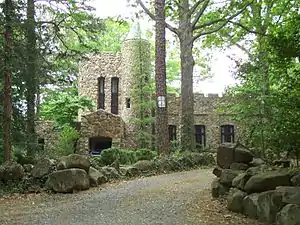Order of Gimghoul
The Order of Gimghoul is a collegiate secret society headquartered at Hippol (or Gimghoul) Castle in Chapel Hill, North Carolina.[1][2] The order was founded in 1889 by Robert Worth Bingham, Shepard Bryan, William W. Davies, Edward Wray Martin, and Andrew Henry Patterson, who were University of North Carolina students at the time.[3]

The society is open to "notable" male students (rising juniors and higher), and faculty members by invitation. The society centers itself around the legend of Peter Dromgoole, a student who mysteriously disappeared from campus in 1833.[4][5] The founders originally called themselves the Order of Dromgoole, but later changed it to the Order of Gimghoul, "in accord with midnight and graves and weirdness," according to archives.[3]
Tradition has it that the order held to the "Dromgoole legend and the ideals of Arthurian knighthood and chivalry." From all accounts, the order is social in nature, and is believed to have no clandestine agenda. Membership is closed and information about the order is strictly confidential as is access to archives less than 50 years old.[3]
The meeting place of the order, Hippol Castle, was built in 1924 at a cost of nearly $50,000.[6] Thirteen hundred tons of rough stone were used in its construction giving it the appearance of a castle.[7] To finance its construction, the Order sold 35 acres of property that was later designated the Gimghoul Neighborhood Historic District.[8] The castle is located at the end of Gimghoul Road, not far from Old Chapel Hill Cemetery on campus near Carmichael Auditorium.[9] According to real estate records, the 2.15-acre (8,700 m2) site is owned by a non-profit corporation entitled the Order of the Gimghoul and has a taxable value of over $1 million.[1][10] The castle is a contributing building in the Chapel Hill Historic District.
The Chris Gethard Show, a public access comedy television show in New York, has filmed a number of semi-tongue-in-cheek "exposés" on the Order, none of which have substantiated any of the show's allegations.[11]
Archival material
The archives of the Order of Gimghoul are available in Wilson Library, although access to records less than 50 years old requires permission of the Order.[12]
References
- "HALLOWEEN: Secret Society In Chapel Hill Owns Gimghoul Castle". Raleigh Telegram. Archived from the original on 2012-11-09. Retrieved 2012-10-31.
- "Gimghoul Castle". WelcomeToNC.com. Archived from the original on 2008-04-10. Retrieved 2008-05-04.
- "Inventory of the Order of Gimghoul Records, 1832-2006 (bulk 1940-1997)". UNC Libraries. Retrieved 2008-05-04.
- "The Legend of Gimghoul". Ghost Stories of North Carolina. ibiblio.org. Retrieved 2008-05-04.
- Elliston, Jon; Priestley, Kent (2007). "Positively Goole-ish". North Carolina Curiosities: Quirky Characters, Roadside Oddities & Other Offbeat Stuff. Guilford, CT: The Globe Pequot Press. p. 102. ISBN 0-7627-4366-2. Retrieved 2008-05-09.
- "Gimghoul Castle". Carrboro.com. Retrieved 2008-05-04.
- Valle, Kirsten (2004-10-29). "Secret society prompts ghoulish legends". The Daily Tar Heel. Archived from the original on 2008-05-21. Retrieved 2008-05-09.
- M. Ruth Little (February 1993). "Gimghoul Neighborhood Historic District" (pdf). National Register of Historic Places - Nomination and Inventory. North Carolina State Historic Preservation Office. Retrieved 2015-02-01.
- "Gimghoul Castle, University of North Carolina, Chapel Hill, N.C." North Carolina Postcards. Retrieved 2008-05-04.
- "Orange County Land Records". Data Summary Information Page Gimghoul Castle. Retrieved 2008-05-09.
- "Murf Vs. Gimghoul: HOUR-LONG SCUMBUM EXPOSING SPECIAL". Retrieved 20 December 2013.
- University Archives, Wilson Library, University of North Carolina at Chapel Hill. "Collection Title: Order of Gimghoul of the University of North Carolina at Chapel Hill Records, 1832-2009 (bulk 1940-1997}".CS1 maint: multiple names: authors list (link)
